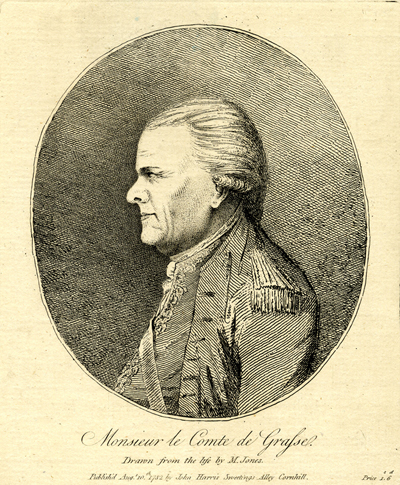Monsieur le Comte de Grasse
This is one of many early prints that Dorothy George believes are likely to have been created by Gillray, but are either unsigned or, as in this case, signed with an alias–M. Jones.

© Trustees of the British Museum
In August of 1782, Le Comte de Grasse achieved what must have been for him the worst kind of notoriety as the unlucky loser of the April 9–12, 1782 Battle of the Saintes. He was defeated in that decisive battle by Admiral George Rodney; his flagship, the Ville de Paris, was seized; and he and some 5000 of his men were captured and made prisoners of war. Gillray had already created four prints in May and June of 1782 relating to the battle and its political consequences. But all of Gillray's portrayals of de Grasse were versions of the starved effete Frenchman familiar to his British audience from macaroni prints. Now on August 3rd, de Grasse had arrived in London in person for all to see.
There had been consistent interest in the Frenchman since May 19 when the first reports of the battle reached England. At Sadler's Wells, for instance, there was a piece advertised in several of the London newspapers "called HUZZA FOR OLD ENGLAND...Containing among various pieces of Machinery a lively Representation of. . . the gallant DE GRASSE surrendering his sword to VICTORIOUS RODNEY, Fame hovering over the Latter, about to crown him with the Laurel Wreath."
As a nobleman and Admiral, according to the etiquette of the time, de Grasse was treated more like an invited guest than an enemy combatant. Before his return to France on August 12, he seems to have been able to spend his time much as he wished. We hear of him visiting a Mr. Katterfelto to observe his "New Improved SOLAR MICROSCOPE and attending lectures, "that he may give a full account to Dr. [Benjamin] Franklin at Paris." So Gillray would have had opportunity as well as financial incentive to produce an accurate portrait of de Grasse. And if the publication date of August 10 is indeed accurate, he produced his portrait within a week of de Grasse's arrival in London.
As usual in the competitive world of freelance graphics, Gillray was not alone in seizing the opportunity. By September 2nd, there were at least two other portraits of de Grasse advertised in the Morning Chronicle and London Advertiser. One "drawn from the life at the Royal Hotel on the 8th and 9th of August by Mr. Miller and engraved by Angus" priced at a shilling (thereby under-selling Gillray by sixpence), and a "fine mezzotint, priced at 5 shillings based upon a painting by Mr. Walker.
Sources and Reading
- Commentary from the British Museum on Monsieur le Comte de Grasse
- "François Joseph Paul de Grasse," Wikipedia
- "Battle of the Saintes," Wikipedia
Comments & Corrections
NOTE: Comments and/or corrections are always appreciated. To make that easier, I have included a form below that you can use. I promise never to share any of the info provided without your express permission.